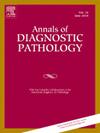SSTR2A、ATRX和clusterin免疫组化表达在高级别胃肠胰神经内分泌肿瘤中的诊断价值
IF 1.4
4区 医学
Q3 PATHOLOGY
引用次数: 0
摘要
高级别胃肠胰神经内分泌肿瘤(NENs)是一类异质性的罕见肿瘤,分为3级高分化神经内分泌肿瘤(G3 NETs)和低分化神经内分泌癌(NECs)。区分G3网络和nec是一项挑战。我们旨在总结G3 NETs的临床病理特点;检测G3 NETs和NECs中生长抑素受体2A (SSTR2A)、clusterin和ATRX的表达;并探讨联合这些标志物对G3 NETs鉴别诊断的诊断和预后价值。回顾性收集87例高级别NENs (G3 NETs: 18例,nec: 69例)患者资料,并根据WHO第5版消化系统肿瘤分类进行分类。对SSTR2A、ATRX和clusterin进行免疫组化。分析蛋白表达与临床病理特征的关系。使用受试者工作特征曲线评估联合这些指标的诊断意义。G3 NETs的SSTR2A蛋白表达、ATRX表达缺失和clusterin阳性率均显著高于nec[分别为77.8%(14/18)比42.0%(29/69)、61.1%(11/18)比33.3%(23/69)、77.8%(14/18)比30.4%(21/69)]。ATRX表达缺失在大细胞NECs中比在小细胞NECs中更为常见。在G3 NETs与nec的鉴别中,SSTR2A、clusterin、ATRX联合诊断的曲线下面积显著高于单个值(分别为0.833、0.679、0.737、0.639)。联合使用SSTR2A、clusterin和ATRX可以提高诊断的准确性。我们的免疫组织化学评估为区分G3 NETs和nec提供了诊断见解。本文章由计算机程序翻译,如有差异,请以英文原文为准。
Diagnostic value of SSTR2A, ATRX, and clusterin immunohistochemical expression in high-grade gastroenteropancreatic neuroendocrine neoplasms
High-grade gastroenteropancreatic neuroendocrine neoplasms (NENs) are a heterogeneous group of rare tumors, classified into well-differentiated neuroendocrine tumors grade 3 (G3 NETs) and poorly differentiated neuroendocrine carcinomas (NECs). Distinguishing G3 NETs from NECs is challenging. We aimed to summarize the clinicopathologic characteristics of G3 NETs; examine the expression of somatostatin receptor 2A (SSTR2A), clusterin, and ATRX in G3 NETs and NECs; and explore the diagnostic and prognostic value of combining these markers for the differential diagnosis of G3 NETs. Data on 87 patients with high-grade NENs (G3 NETs: 18, NECs: 69) were retrospectively collected and classified according to the 5th edition of the WHO Classification of Digestive System Tumors. Immunohistochemistry was performed for SSTR2A, ATRX, and clusterin. Relationships between protein expression and clinicopathological features were analyzed. The diagnostic significance of combining these markers was assessed using receiver operating characteristic curves. SSTR2A protein expression, loss of ATRX expression, and positivity rate for clusterin were significantly higher in G3 NETs than in NECs [77.8 % (14/18) vs. 42.0 % (29/69), 61.1 % (11/18) vs. 33.3 % (23/69), and 77.8 % (14/18) vs. 30.4 % (21/69), respectively]. ATRX expression loss was significantly more common in large-cell than small-cell NECs. In differentiating G3 NETs from NECs, the area under the curve of the combined diagnosis using SSTR2A, clusterin, and ATRX was significantly higher than the individual values (0.833 vs. 0.679, 0.737, and 0.639, respectively). Combining SSTR2A, clusterin, and ATRX improves diagnostic accuracy. Our immunohistochemical assessment provides diagnostic insights for distinguishing G3 NETs from NECs.
求助全文
通过发布文献求助,成功后即可免费获取论文全文。
去求助
来源期刊
CiteScore
3.90
自引率
5.00%
发文量
149
审稿时长
26 days
期刊介绍:
A peer-reviewed journal devoted to the publication of articles dealing with traditional morphologic studies using standard diagnostic techniques and stressing clinicopathological correlations and scientific observation of relevance to the daily practice of pathology. Special features include pathologic-radiologic correlations and pathologic-cytologic correlations.

 求助内容:
求助内容: 应助结果提醒方式:
应助结果提醒方式:


